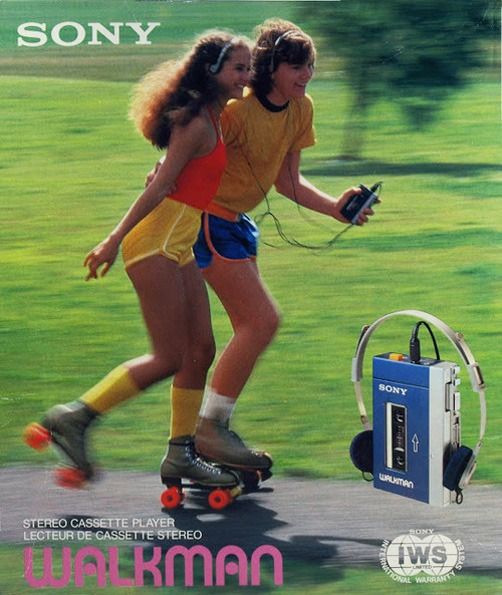A Brief History of the Walkman
On 1st July 1979, Sony released their first Walkman model in Japan. In the years that followed, over 385 million Walkmans would be sold worldwide. Sony’s release of the Walkman revolutionised our listening habits. The development of the Walkman is credited with paving the way towards future technologies such as the MP3 player and the iPod. Expanding the possibilities of experiencing music on-the-go, this innovation represents a landmark moment in the history of Outdoor Audio.

Before the Walkman
Before Sony invented the Walkman, Transistor Radios were the main way in which people enjoyed portable audio. During the 1950s, these radios had been designed to be pocket-sized however the listener was extremely limited. Each user was restricted to whichever radio stations could be reached in their location, and whatever tracks were playing on each programme.

The Boombox was a popular alternative that provided audio on-the-go. As a portable device, the Boombox catered to a specific audience. Deeply embedded within Hip Hop and Break Dancing culture, the Boombox was used to share, perform and create music, rather than to privately enjoy portable audio. The popularity of the Boombox in the 1970s, however, was soon hindered by the introduction of noise ordinance laws in major cities.
Read more about the History of the Boombox in our dedicated article.

The Origins of The Walkman
The Walkman would be developed in response to the shortcoming of both the Transistor Radio and the Boombox. Users desired greater choice as to what they could listen to on-the-go, as well as the possibility of private listening. The Walkman would soon carve out its own space somewhere between these two audio devices, offering a solution to both these wishes.
During the late 1970s, one of Sony’s co-founders, Masaru Ibuka, was using the Sony TC-D5 cassette recorder to listen to Opera music as he travelled. This device was bulky and impractical to carry long distances. Masaru Ibuka asked Sony’s Norio Ohga if it would be possible to develop a more portable device that could be designed specifically to listen to music via headphones.

Sony had previously released a portable recording device called the Pressman, which was targeted at journalists and secretaries. The first Walkman model was made by adapting the features of Sony’s Pressman. A stereo amplifier was installed, and the mechanism that enabled journalists to make recordings onto cassette tapes was removed. This new adapted model was released under the name of TPS-L2 in Japan on 1st July 1979. It was blue and silver, ran off two AA batteries and was fitted with bulky buttons. The TPS-L2 had two headphone jacks so that two people could listen at the same time.
The task of naming this new device proved difficult for Sony. It was challenging to find a name that wasn’t trademarked across different countries. For the international release of the TPS-L2 outside Japan, it was first introduced as the ‘Sound-About’ in the USA, the ‘Stowaway’ in the UK and the ‘Freestyle’ in Sweden. The now iconic name ‘Walkman’ emerged as an amendment to the Sony Pressman.

The Growth
The release of the Walkman was met with international success. Sony initially anticipated that only 5000 models would be sold a month. Within the first two months however, 50,000 Walkmans had been purchased by the public. Thanks to a creative marketing campaign, Sony’s sales steadily began to increase worldwide.

Sony soon announced the second-generation Walkman, the WM-2, just 19 months after the device’s initial release. Compared with the first prototype, this version had been dramatically reduced in size. The WM-2’s design represents the iconic, nostalgic Walkman model for many worldwide. With each new model released, Sony continued to adapt and update the Walkman. Features such as AM/FM receivers and auto-reverse were added. By 1990, Sony had released over 80 different variants of the Walkman. Other technology competitors such as Aiwa, Panasonic and Toshiba invented their own similar portable audio devices, but the Walkman consistently remained ahead in the market.

The introduction of CD’s in 1982 momentarily put the Walkman’s continued success into question. Sony responded quickly and released their first portable CD player, the Discman, just two years after the CD was first introduced to the public.

The impact that Sony’s Walkman has had on the ways in which we experience music must not be understated. As the first device to introduce the concept of listening to your own music on-the-go, the Walkman inspired the later development of the Discman, the MP3 player and the iPod. The Walkman is more than just the defining accessory of the 1980s, it changed our listening habits forever and symbolises a critical shift in the history of Outdoor Audio.
